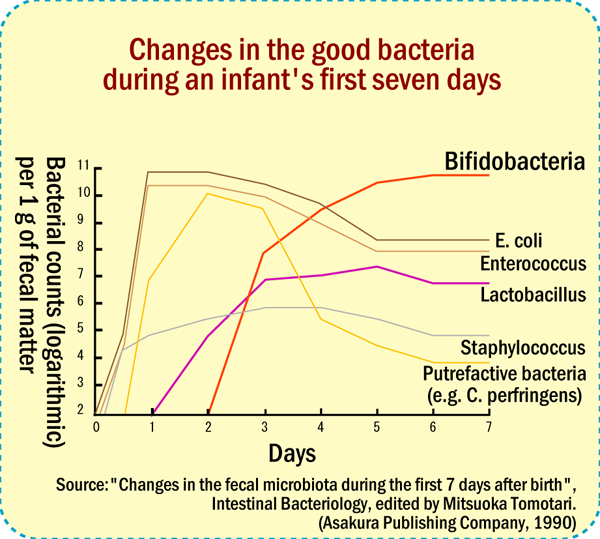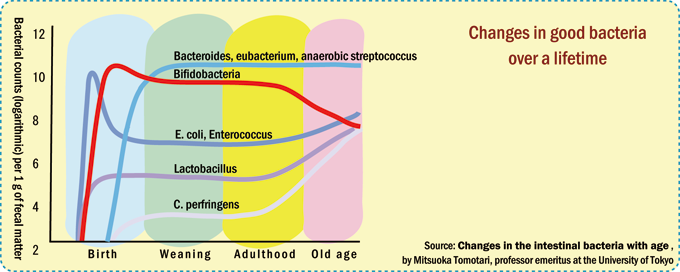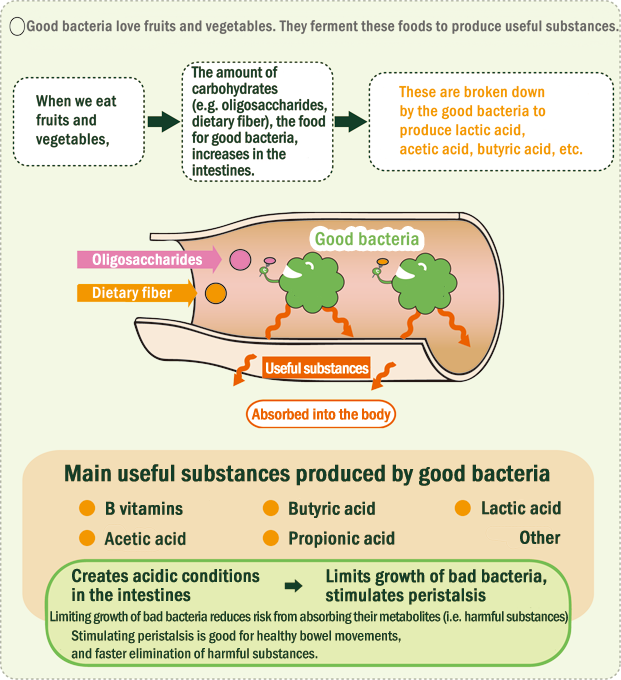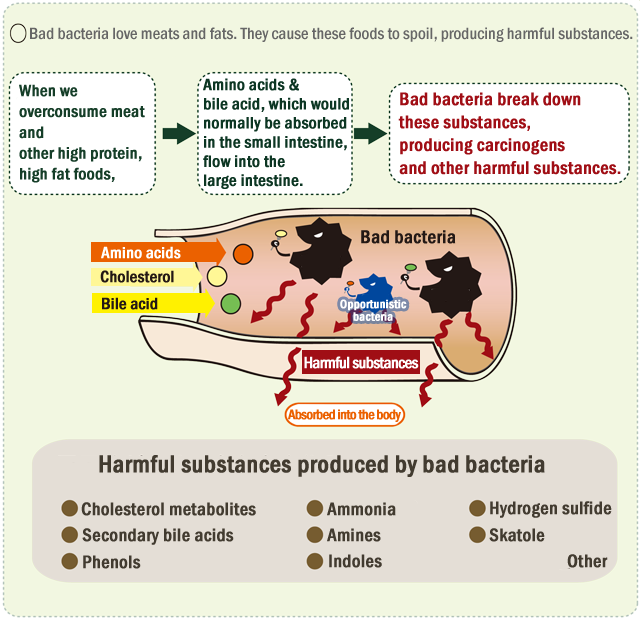what is gut-flora
Gut flora? What's that?

The gut flora: No two are alike.
Each of us has countless numbers of bacteria living in our intestines. These are known as the enterobacteria. There are over 100 species and roughly 1 trillion individual bacteria living inside our intestines.
In the section of the intestines from the ileum (the final part of the small intestine) leading into the large intestine, different varieties of enterobacteria group together by species in huge numbers, lining the walls of the intestines.
If you can imagine, it's a bit like plants in a garden, with each of the different types growing together in large groups. Hence, the term "gut flora".
Our gut flora, these various types of bacteria living in our intestines, are as unique and individual as our faces or personalities. What's more, certain factors such as lifestyle, age, and stress can cause changes in our gut flora.
Taking a closer look at the gut flora, We find that the enterobacteria are basically categorized into three groups, depending on what they do.
(1)"Good" bacteria
These bacteria play a useful role in the human body.
(2)"Bad" bacteria
These bacteria produce toxic substances and can cause putrefaction (spoilage) in the gut.
(3)Opportunistic bacteria
These are neither good nor bad, but can side with either depending on the prevailing conditions.
In the gut of a healthy individual, the good bacteria keep the bad bacteria under control, maintaining a constant balance. But if certain factors cause the numbers of bad bacteria to get out of hand, it can lead to putrefaction in the gut and increased levels of harmful substances such as ammonia, phenols and indoles. These substances can be a cause of smelly flatulence, or worse. For example, having been absorbed in the intestinal tract, these substances can end up putting an increased strain on the liver, heart, kidneys and other organs (speeding up the aging process), and even increase the risk of cancers and other types of lifestyle-related illness.
For the gut flora, the ideal is said to be:
20% good bacteria
10% bad bacteria
70% opportunistic bacteria
For anyone hoping to stay healthy, it would be great if this balance in the gut flora could be maintained at all times. But this balance can change as a result of factors such as age, eating habits, and stress. Unfortunately, lifestyle, stress and eating habits are almost impossible to improve overnight. This is one reason why more and more people are turning to fermented foods to help maintain good conditions in the gut, and why many are eating foods fortified with lactic acid bacteria and taking supplements.
The different types of enterobacteria
First, let's look at the three basic categories of intestinal bacteria that make up the gut flora.
| Type | What they do | Typical examples |
|
Good bacteria (useful bacteria) |
These bacteria help prevent intrusion and proliferation of bad bacteria, stimulate intestinal movement, and generally play a useful role in the body. |
・Bifidobacteria ・Lactobacillus ・Faecalis bacteria ・Acidophilus bacteria |
|
Bad bacteria (putrefactive bacteria) |
These bacteria produce toxic substances and can cause spoilage in the gut. |
・Clostridia (e.g. Clostridium perfringens) ・Staphylococcus ・Veillonella |
| Opportunistic bacteria |
Normally not considered good or bad, these microbes can act as bad bacteria when the body is in a weakened state. |
・E. coli ・Bacteroides |
Three characteristics of the gut flora
![]() The gut flora is different in every person.
The gut flora is different in every person.
Just as no two faces or sets of fingerprints are alike, the gut flora are different in every person. The proportions of the good, bad and opportunistic bacteria will be relatively consistent among healthy individuals, with the good bacteria in a dominant position. This is what is known as bacterial balance.
![]() There's a constant battle happening inside the gut.
There's a constant battle happening inside the gut.
Inside our intestines, the good bacteria and bad bacteria are engaged in a struggle for survival that never stops. As one side increases in number, the other loses ground, because the overall counts are somewhat fixed. In that sense, both sides are in a constant battle to claim enemy territory. If something happens to upset the bacterial balance and the bad bacteria get out control, the intestinal environment deteriorates and the body may fall ill.
![]() All of us are in a symbiotic relationship with our intestinal bacteria.
All of us are in a symbiotic relationship with our intestinal bacteria.
In other words, we provide the enterobacteria with food and a place to live. In return, they produce a variety of metabolites. Typically, the good bacteria will absorb sugars and other carbohydrates and produce organic acids such as lactic acid and butyric acid. This creates acidic conditions in the intestines and keeps the growth of bad bacteria in check. The good bacteria help keep us healthy in many ways, by keeping invading bacteria out of the body, breaking down harmful substances produced by the bad bacteria, stimulating the peristaltic movement of the intestines, and producing B vitamins and other useful substances.
Changes in the gut flora

![]() Infants
Infants
Before being born, babies have sterile gastrointestinal tracts.……
- Right after birth, E. coli and other microbes find their way in.
- At three to four days, the baby will have a high count of bifidobacteria (a key type of good bacteria), which are present in the mother's milk.
- When the baby starts eating solid food, she will get other types of bacteria with it, and her individual gut flora will be basically determined.


![]() As we age
As we age
As we grow older, the bad bacteria start to be of greater concern.……
- C. perfringens and other bad bacteria grow in number.
- When we reach old age, the bifidobacteria start to decrease in number.

Remember that even when we're young, unhealthy lifestyles can cause an upset in the bacterial balance such that we start to experience problems before reaching old age.
That's why we can't allow the bad bacteria to get out of hand, no matter what our age.
Intestinal bacteria: An important partner Food and the intestinal bacteria
The gut flora is very delicate. It can be affected by many things besides aging. These include misuse of antibiotics and other medications, emotional stress, and lack of exercise. Another big factor is our daily diet. So let's examine the relationship between diet and the intestinal bacteria, shall we?


Advances in gut flora research
The study of the gut flora began in 1681, when Dutch scientist Antonie van Leeuwenhoek first observed bacteria in a stool sample under a microscope. Later, starting in the 1800s, various researchers identified the major species of bacteria that comprise the gut flora, but the systematic work was yet to come.
A Japanese researcher would be the first to conduct a systematic study of the gut flora. In the process, he established a new branch of scholarship called Intestinal Bacteriology. That man was Dr. Mitsuoka Tomotari, professor emeritus at the University of Tokyo. Since the 1970s, Dr. Mitsuoka has been a proponent of the links between the gut flora and host, and of the idea that the balance of the intestinal environment plays a crucial role in human health and pathology.
Today, research on the gut flora is being conducted all over the world. For example, Dr. Jeffery Gordon of Washington University in St. Louis discussed his findings that the gut flora plays a role in host obesity in a paper published in the December 21, 2006 issue of the scientific journal Nature.
Intestinal bacteriology got its start in the years after the Second World War. And while there is still much to learn, progress is being made as scientists continue to study the deep links between our lifestyles and medical issues such as cancer, diabetes and depression, as well as those of a more cosmetic nature, like the condition of one's skin.

